September 2014
Månader under 2014: |
Händelser
2 september
3 september
- USA:s president Barack Obama besöker Estland.
5 september
- Regeringen i Ukraina och de proryska rebellerna enas om en vapenvila.
6 september
- En duva satt på en gren och funderade på tillvaron av Roy Andersson blir första svenska film att belönas med Guldlejonet.
- I samband med ett vattenledningsarbete hittas 5 vikingagravar från runt 1000-talet vid Stora Törnekvior i östra Visby[1].
8 september
- Iraks parlament röstar om en ny regering. Tillsättandet är avgörande för om landet ska kunna stoppa extremistmilisen Islamiska statens frammarsch.
11 september
- Uppsala kommun säger nej till civilflyg på Ärna flygplats.
13 september
- USA förklarar krig mot ISIL.
- Hundratals aktivister drabbar samman i Serbiens huvudstad Belgrad efter att en tysk hbtq-aktivist misshandlats till döds[2].
- 30 dödas när en lastbil som transporterar oljefat störtar ner i en ravin nära staden Boali i Centralafrikanska republiken.
14 september
- Riksdagsvalet i Sverige 2014[3] resulterar i en förändrad majoritet i riksdagen där Alliansen hamnar i minoritet mot blocket Socialdemokraterna–Vänsterpartiet–Miljöpartiet. Sverigedemokraterna blir tredje största parti. Så snart valresultatet står klart meddelar Statsminister Fredrik Reinfeldt att han kommer att lämna såväl statsministerposten som posten som partiledare för Moderaterna.
15 september
- Ett jordskalv med 4,0 på richterskalan skakar mellersta Sverige.
- Piloter hos Air France och Lufthansa strejkar, vilket påverkar flygtrafiken över Europa.
- Efter en kommunal folkomröstning i Göteborg blir det nej till trängselskatt.
- En ny lag införs i Österrike, som innebär att man förbjuder symboler för närmare 20 extremistiska grupperingar. Lagen infördes mot bakgrund av att fler än 140 personer har lämnat Österrike för att strida för extremistiska islamistiska grupperingar i Mellanöstern.
16 september
- Hanna Stjärne utses till ny VD för Sveriges Television.
- Forskare från Sverige och Argentina upptäcker en ny fossil som är mellan 65 och 35 miljoner år gammal på Seymourön. Det är det äldsta landlevande däggdjuret på Antarktis.
17 september
- I Kambodjas huvudstad Phnom Penh samlas 100-tals textilarbetare och protesterar mot sina låga löner[4].
19 september
- Folkomröstningen om skotsk självständighet resulterar i att Skottland inte blir självständigt, då en majoritet (55,3 procent) röstade nej till skotsk självständighet, medan 44,7 röstade ja.
- Ugandas president Yoweri Museveni avgår.
20 september
- Turkiet öppnade gränsen för de närmare 70 000 kurdiska syrier som flyr i fruktan för jihadistiska Islamiska Staten (ISIL)[5].
22 september
- 115 människor dödas i ett husras i Lagos, Nigeria.
- NASA:s sond MAVEN kommer in i omloppsbana runt Mars och skall studera planetens atmosfär.
23 september
- Inbördeskriget i Syrien: Saudiarabien, Jordanien, Qatar, Bahrain, Förenade Arabemiraten med USA i spetsen utför flyganfall i norra Syrien där den islamiska extremistgruppen ISIL håller till[6][7].
- Israel sköt ner ett syriskt mig-plan över Golanhöjderna.
24 september
- I Rumänien inleds rättegången mot massövergreppen, som begicks under Kommunisttiden[8].
25 september
26 september
- I Uzbekistan fängslas över tusentals regimmotståndare som kommit på kant med den auktoritäre diktatorn Islam Karimovs regim. Inte ens hans egen dotter Gulnara Karimova kommer undan.
27 september
- Vulkanen Ontake i Japan får utbrott, och minst 47 personer har avlidit.
28 september
- Demonstranter samlas i Hongkong för att demonstrera mot föreslagna valreformer som har tillkännagetts av den kinesiska regeringen.
- I både Sverige och Estland uppmärksammas 20-årsdagen efter Estoniakatastrofen.
29 september
- Sveriges riksdag samlas efter valet 14 september och Urban Ahlin (S) utses till riksdagens talman.
Källor
- ^ ”Elever hittade ytterligare vikingagrav”. 5 september 2022. http://sverigesradio.se/sida/artikel.aspx?programid=94&artikel=5956468. Läst 6 september 2014.
- ^ http://www.aftonbladet.se/senastenytt/ttnyheter/utrikes/article19528478.ab
- ^ Proposition 2009/2010:80 En reformerad grundlag, 5.2 Valdagen tidigareläggs
- ^ ”Nya textilprotester i Kambodja”. 17 september 2014. http://www.svt.se/nyheter/utrikes/nya-textilprotester-i-kambodja-1. Läst 17 september 2014.
- ^ ”45.000 syriska kurder flydde”. 20 september 2014. http://www.svt.se/nyheter/utrikes/45-000-syriska-kurder-flydde. Läst 20 september 2014.
- ^ http://www.aftonbladet.se/nyheter/article19578737.ab
- ^ ”USA till stor attack mot IS i Syrien”. 23 september 2014. http://www.svt.se/nyheter/utrikes/flyganfall-mot-is-i-syrien. Läst 23 september 2014.
- ^ ”Kommunismens brott upp i domstol i Rumänien”. 24 september 2014. http://sverigesradio.se/sida/artikel.aspx?programid=83&artikel=5973244. Läst 24 september 2014.
- ^ ”Två tonåringar hittade ihjälskjutna”. 25 september 2014. http://www.svt.se/nyheter/lokalt/uppsala/tva-tonaringar-hittade-ihjalskjutna. Läst 25 september 2014.
Externa länkar
 Wikimedia Commons har media som rör September 2014.
Wikimedia Commons har media som rör September 2014.
Månader under 2014: |
Media som används på denna webbplats
Författare/Upphovsman: Janwikifoto, Licens: CC BY-SA 3.0
Urban Ahlin
Författare/Upphovsman: UKPhoenix79, Licens: CC BY-SA 3.0
Image of Scotland in the UK
NASA's Newest Mars Mission Spacecraft Enters Orbit around Red Planet
September 21, 2014
http://www.jpl.nasa.gov/news/news.php?release=2014-318
[IMAGE] MAVEN (Artist's Concept) This image shows an artist concept of NASA's Mars Atmosphere and Volatile Evolution (MAVEN) mission.
NASA's Mars Atmosphere and Volatile Evolution (MAVEN) spacecraft successfully entered Mars' orbit at 7:24 p.m. PDT (10:24 p.m. EDT) Sunday, Sept. 21, where it now will prepare to study the Red Planet's upper atmosphere as never done before. MAVEN is the first spacecraft dedicated to exploring the tenuous upper atmosphere of Mars.
"As the first orbiter dedicated to studying Mars' upper atmosphere, MAVEN will greatly improve our understanding of the history of the Martian atmosphere, how the climate has changed over time, and how that has influenced the evolution of the surface and the potential habitability of the planet," said NASA Administrator Charles Bolden. "It also will better inform a future mission to send humans to the Red Planet in the 2030s."
After a 10-month journey, confirmation of successful orbit insertion was received from MAVEN data observed at the Lockheed Martin operations center in Littleton, Colorado, as well as from tracking data monitored at NASA's Jet Propulsion Laboratory navigation facility in Pasadena, California. The telemetry and tracking data were received by NASA's Deep Space Network antenna station in Canberra, Australia.
"NASA has a long history of scientific discovery at Mars and the safe arrival of MAVEN opens another chapter," said John Grunsfeld, astronaut and associate administrator of the NASA Science Mission Directorate at the agency's Headquarters in Washington. "Maven will complement NASA's other Martian robotic explorers-and those of our partners around the globe-to answer some fundamental questions about Mars and life beyond Earth."
Following orbit insertion, MAVEN will begin a six-week commissioning phase that includes maneuvering into its final science orbit and testing the instruments and science-mapping commands. MAVEN then will begin its one Earth-year primary mission, taking measurements of the composition, structure and escape of gases in Mars' upper atmosphere and its interaction with the sun and solar wind.
"It's taken 11 years from the original concept for MAVEN to now having a spacecraft in orbit at Mars," said Bruce Jakosky, MAVEN principal investigator with the Laboratory for Atmospheric and Space Physics at the University of Colorado, Boulder (CU/LASP). "I'm delighted to be here safely and successfully, and looking forward to starting our science mission."
The primary mission includes five "deep-dip" campaigns, in which MAVEN's periapsis, or lowest orbit altitude, will be lowered from 93 miles (150 kilometers) to about 77 miles (125 kilometers). These measurements will provide information down to where the upper and lower atmospheres meet, giving scientists a full profile of the upper tier.
"This was a very big day for MAVEN," said David Mitchell, MAVEN project manager from NASA's Goddard Space Flight Center, Greenbelt, Maryland. "We're very excited to join the constellation of spacecraft in orbit at Mars and on the surface of the Red Planet. The commissioning phase will keep the operations team busy for the next six weeks, and then we'll begin, at last, the science phase of the mission. Congratulations to the team for a job well done today."
MAVEN launched Nov. 18, 2013, from Cape Canaveral Air Force Station in Florida, carrying three instrument packages. The Particles and Fields Package, built by the University of California at Berkeley with support from CU/LASP and Goddard, contains six instruments that will characterize the solar wind and the ionosphere of the planet. The Remote Sensing Package, built by CU/LASP, will identify characteristics present throughout the upper atmosphere and ionosphere. The Neutral Gas and Ion Mass Spectrometer, provided by Goddard, will measure the composition and isotopes of atomic particles.
The spacecraft's principal investigator is based at CU/LASP. The university provided two science instruments and leads science operations, as well as education and public outreach, for the mission.
NASA Goddard Space Flight Center manages the project and also provided two science instruments for the mission. Lockheed Martin built the spacecraft and is responsible for mission operations. The Space Sciences Laboratory at the University of California at Berkeley provided four science instruments for MAVEN. JPL provides navigation and Deep Space Network support, and Electra telecommunications relay hardware and operations. JPL, a division of the California Institute of Technology in Pasadena, manages the Mars Exploration Program for NASA.
To learn more about the MAVEN mission, visit:
and
http://mars.nasa.gov/maven/




